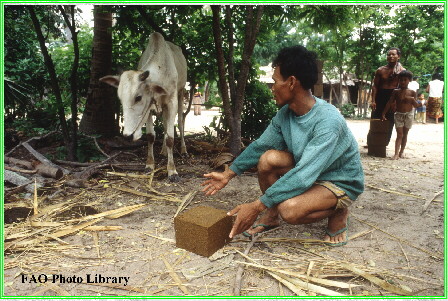

Many ruminant animals exist on the crop residues or poor quality grazing. Such feeds fail to meet even the maintenance requirements unless they are supplemented with additional nutrients. The supplement can be in the form of commercially prepared concentrate but this is often not readily available or too expensive for farmers in many countries. One convenient and inexpensive way to improve the diet is through provision of a multinutrient block. Blocks can be made from a number of formulas but usually contain molasses to increase palatability and to provide a readily available carbohydrate source for rumen fermentation. Urea is also included to provides the nitrogen necessary for microbial protein synthesis. Fibrous material such as wheat bran, rice bran, groundnut hulls, cottonseed hulls or bagasse provide structure and some protein and phosphorous. The ingredients, plus additional minerals and salt if necessary, are mixed with a gelling or solidifying agent such as calcium oxide, bentonite or cement.
After a thorough mixing of the ingredients, the thick liquid may be heated and then poured into molds until it solidifies. Alternately, it can be placed into molds without heating but the setting time will be increased with this method.
The precise formulation affects hardness and some experimentation may be necessary to determine appropriate concentrations when using local ingredients. Blocks that are too soft may be consumed too quickly. Animals obtain very little from those that are too hard so the blocks may not provide sufficient supplementation.

Additional information on making and using urea-molasses blocks can be obtained from:
Preston, T.R. & R.A. Leng. 1987. Matching ruminant production systems with available resources in the tropics and sub-tropics. Perambule Books. Armidale.
Sansoucy, R., G. Aarts & R.A. Leng. Molasses/Urea Blocks. Information extracted from FAO Tropical Feeds Database.